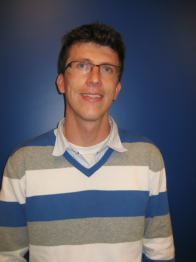Interfacial phenomena in micro- and nanofluidics: nanobubbles, cavitation, and wetting
Promotion date: 2. October 2009
Promotor: Prof. Dr. Detlef Lohse
| In this thesis project, water in contact with a hydrophobic surface is studied in three different ways: -Spherically cap-shaped gas bubbles on atomically smooth surfaces (10-100 nm) -Gas pockets, trapped in extremely small surface defects, growing to micrometer sized vapour bubbles (100 – 1000 nm). This phenomenon is called cavitation. Wetting a rough, superhydrophobic surface (1 – 10 µm). |
What was the initial purpose of your thesis project?
The study of interfacial phenomena on hydrophobic surfaces, was the general issue right from the start. At first sight, one would expect nothing special will happen there.
Using AFM measurements, however, we found surface nanobubbles, possessing an extremely small radius of curvature. This leads to the central question why these bubbles can exist in a stable manner, at the first place. We don’t have an exact answer for this phenomenon yet, but we know contamination plays an important role. It caught the attention of the Dutch multinational company ASML.
A second phenomenon under investigation involved cavitation bubbles, emerging from nano-sized pits filled with gas. Manipulating pressure and geometry, we were able to control the spectacular growth of these bubbles, to more than ten micrometers in size. This far-reaching level of controllability can be of special interest for cleaning wafers in the future, which is a billion dollar market. Another feature of the cavitation processes involved, was taken up by Philips Natlab, one of the partners in NanoNed/STW. My project was part of this national research program.
At the time two post-docs and two graduates are working on these research topics.
Can you recall a special moment? Let’s say, a kind of breakthrough moment ...
One Friday afternoon was very special, because all good things came together. It involved the third line of investigation: superhydrophobic surfaces, for example polymer material, decorated with physical roughness, in this case nanometer sized pillars in a regular pattern.
Under certain conditions, it is energetically more favourable for a water droplet to wet the structure completely, using the space between the pillars. The velocity of the wetting front, diverges as the dimensions of the structure approach a critical value, with square-shaped wetted areas as a direct result.
This special afternoon we were very fortunate, as the size and pattern of the pillars appeared to be just right, and we made wonderful recordings using a high-speed camera.
Together with two post-docs and two graduates, we managed to publish the surprising observations in Physical Review Letters.
In what way did you develop personally, as a researcher, during these four years?
After the first three months, I was really worried and questioned continuation of the project seriously. The first experiments didn’t come out right. The results were not as expected at all.
Then a dear colleague told me: “Just continue! It’s all about getting new ideas. You should worry when you don’t have new ideas anymore. Otherwise, just continue.”
These words inspired me a great deal. Gradually nervousness became patience. I am very grateful for this advice, and achieved really nice scientific results, and a lot of attention from leading companies. In the end my thesis was rewarded with distinction.
In the beginning I needed a lot of coaching and was more awaiting in my actions. This changed. I learned to look for cooperation more and to organize my own projects. As a member of the Physics of Fluids group, it is important to do so. I worked closely together with professor Schönherr (polymers) and professor Matthias Wessling (membranes).
In the future, be it as an academic researcher or in the industry, I will actively search this component in my new job. Also, I would like to perform more application-driven research.
What is in your opinion important for Mesa+ to stay successful?
It is really important to search for cooperation and to make challenging combinations of expertise. I think Mesa+ has a fantastic mix of research lines. I learned that you must not ask other groups and persons for the sake of cooperation alone. First of all, you have to come up with challenging ideas yourself, and approach the right person with a scientific question on his area of expertise. Then new things can happen.

